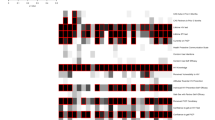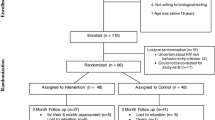Abstract
In Sweden, 57 % of HIV transmission occurs among MSM, and other sexually transmitted infections are increasing, supporting the need for innovative interventions. The Internet is a potentially useful HIV-prevention platform, but there is a lack of such programs in Sweden. The purpose of this exploratory study was to test the efficacy of the Internet-based SMART intervention to decrease HIV sexual risks in Swedish MSM. The intervention was adapted from the Wyoming Rural AIDS Prevention Project to the Swedish context, which was guided by the Information-Motivation-Behavioral (IMB) skills model and consisted of six sessions. A total of 112 men responded to a pretest questionnaire and were randomly assigned to the SMART intervention or to a waitlist group. Fifty-four men dropped out, leaving a final sample of 58 participants. Twenty-five were assigned to the SMART intervention and 33 to a waitlist group. One month post intervention, the number of casual anal sex partners significantly decreased (t = 2.19, p = .04). Compared with the waitlist group, men in the intervention group increased their HIV knowledge (β = 0.70, p = .01), their belief of condom use as an act of responsibility (β = 1.19, p = .04), their willingness to use a condom with every new partner all the time (β = 1.39, p = .03), and their confidence in using condoms in challenging situations (β = 1.65, p = .02). Condom use was not analyzed due to the small sample size. Despite the small sample, high drop-out, and short follow-up, the study provides support for the efficacy of the Internet interventions, the SMART intervention specifically, for reducing the proportion of casual anal sex partners and improving the three cognitive components of the IMB model for Swedish MSM.

Similar content being viewed by others
References
Bakker, A. B., Buunk, B. P., Siero, F. W., & van den Eijnden, P. J. J. M. (1997). Application of a modified health belief model to HIV preventive behavioural interventions among gay and bisexual men. Psychology and Health, 12, 481–492.
Berg, R. (2009). The effectiveness of behavioural and psychosocial HIV/STI prevention interventions for MSM in Europe: A systematic review. European Surveillance, 14, 1424–1427.
Bolding, G., David, M., Hart, G., Sherr, L., & Elford, J. (2005). Gay men who look for sex on the Internet: Is there more HIV/STI risk with online partners? AIDS, 19, 961–968.
Bowen, A. M. (2005). Internet sexuality research with rural MSM: Can we recruit and retain them? Journal of Sex Research, 38, 281–282.
Bowen, A. M., Horvath, K., & Williams, M. L. (2006). Randomized control trial of an Internet delivered HIV knowledge intervention with MSM. Health Education Research, 22, 120–127.
Bowen, A. M., Williams, M. L., Daniel, C. M., & Clayton, S. (2008). Internet based HIV prevention research targeting rural MSM: Feasibility, acceptability, and preliminary efficacy. Journal of Behavioral Medicine, 31, 463–477.
Bull, S., Lloyd, L., Reitmeijer, C., & McFarlane, M. (2004). Recruitment and retention of an online sample for an HIV prevention intervention targeting men who have sex with men: The Smart Sex Quest Project. AIDS Care, 16, 931–943.
Carpenter, K. M., Stoner, S. A., Mikko, A. N., Dhanak, L. P., & Parsons, J. T. (2010). Efficacy of a web-based intervention to reduce sexual risk in men who have sex with men. AIDS and Behavior, 14, 549–557.
Centers for Disease Control (CDC). (2012). Estimated HIV incidence among adults and adolescents in the United States, 2007–2010. HIV Surveillance Supplemental Report 2012; 17(4). Retrieved June 5, 2015 from http://www.cdc.gov/hiv/topics/surveillance/resources/reports/#supplemental.
Chiasson, M. A., Parsons, J. T., Tesoriero, J. M., Carr, P., Hirshfield, S., & Remein, R. H. (2006). HIV behavioral research online. Journal of Urban Health, 83, 73–85.
Cohen, J. (1992). A power primer. Psychological Bulletin, 112, 155–159.
European Center for Disease Prevention and Control. (2013). HIV/AIDS Surveillance in Europe 2013. Retrieved June 5, 2015 from http://ecdc.europa.eu/en/publications/_layouts/forms/.
Fisher, J., & Fisher, W. (2000). Theoretical approaches to individual-level change in HIV risk behavior. In J. Peterson & R. DiClemente (Eds.), Handbook of HIV prevention (pp. 3–55). New York: Plenum Publishers.
Grov, C., Breslow, A. S., Newcomb, M. E., Rosenberger, J. G., & Bauermeister, J. A. (2014). Gay and bisexual men’s use of the Internet: Research from the 1990s through 2013. Journal of Sex Research, 51, 390–409.
Grov, C., Hirshfield, S., Remien, R. H., Humberstone, M., & Chiasson, M. A. (2013). Exploring the venue’s role in risky sexual behavior among gay and bisexual men: An event-level analysis from a national online survey in the US. Archives of Sexual Behavior, 42, 291–302.
Hirshfield, S., Chiasson, M. A., Joseph, H., Scheinmann, R., Johnson, W. D., Remien, R. H., … Margolis, A. D. (2012). An online randomized controlled trial evaluating HIV prevention digital media interventions for men who have sex with men. PLoS One, 7(10), e46252. doi:10.1371/journal.pone.0046252.
Hooper, S., Rosser, B. R. S., Horath, K. J., Oakes, J. M., Danilenko, G., & The Men’s INTernet Sex II (MINTS-II) Team. (2008). An online needs assessment of a virtual community: What men who use the Internet to seek sex with men want in Internet-based HIV prevention. AIDS and Behavior, 12, 867–875.
Horvath, K., Bowen, A., & Williams, M. (2006). Virtual and physical venues as contexts for HIV-risk behaviors among rural men who have sex with men. Health Psychology, 25, 237–242.
Horvath, K. J., Rosser, B. R., & Remafedi, G. (2008). Sexual risk taking among young Internet-using men who have sex with men. American Journal of Public Health, 98, 1059–1067.
Janz, N. K., & Becker, M. H. (1984). The health belief model: A decade later. Health Education and Behavior, 11, 1–47.
Lelutiu-Weinberger, C., Pachankis, J. E., Gamarel, K. E., Surace, A., Golub, S. A., & Parsons, J. T. (2015). Feasibility, acceptability, and preliminary efficacy of a live-chat social media intervention to reduce HIV risk among young men who have sex with men. AIDS and Behavior, 19, 1214–1227.
Liau, A., Millett, G., & Marks, G. (2006). Meta-analytic examination of online sex-seeking and sexual risk behavior among men who have sex with men. Sexually Transmitted Diseases, 33, 576–584.
Mustanski, B. (2007). Are sexual partners met online associated with HIV/STI risk behaviours? Retrospective and daily diary data in conflict. AIDS Care, 19, 822–827.
Mustanski, B., Garofolo, R., Herrick, A., & Donenberg, G. (2007). Psychosocial health problems increase risk for HIV among urban young men who have sex with men: Preliminary evidence of a syndemic in need of attention. Annals of Behavioral Medicine, 34, 37–45.
Mustanski, B., Garofalo, R., Monahan, C., Gratzer, B., & Andrews, R. (2013). Feasibility, acceptability, and preliminary efficacy of an online HIV prevention program for diverse young men who have sex with men: The Keep It Up! intervention. AIDS and Behavior, 17, 2999–3012.
O’Leary, A., Jemmott, J. B., Stevens, R., Rutledge, S. E., & Icard, L. D. (2014). Optimism and education buffer the effects of syndemic conditions on HIV status among African America. AIDS and Behavior, 18, 2080–2088.
Pequegnat, W., Rosser, B. R. S., Bowen, A. M., Bull, S. S., DiClemente, R. J., Bockting, W. O., … Zimmerman, R. (2006). Conducting Internet-based HIV/STD prevention survey research: Considerations in design and evaluation. AIDS and Behavior, 11, 505–521.
Rhodes, S. D., Hergenrather, K. C., Duncan, J., Vissman, A. T., Miller, C., Wilkin, A. M., … Eng, E. (2010). A pilot intervention utilizing Internet chat rooms to prevent HIV risk behaviors among men who have sex with men. Public Health Reports, 125(Suppl. 1), 29–37.
Ross, M. W., Rosser, B. R., Stanton, J., & Konstan, J. A. (2004). Characteristics of Latino men who have sex with men on the Internet who complete and drop out of an Internet-based sexual behavior survey. AIDS Education and Prevention, 16, 526–537.
Rosser, B. R., Grey, J. A., Wilkerson, J. M., Iantaffi, A., Brady, S. S., Smolenski, D. J., & Horvath, K. J. (2012). A commentary on the role of sexually explicit media (SEM) in the transmission and prevention of HIV among men who have sex with men (MSM). AIDS and Behavior, 16, 1373–1381.
Rosser, B. R. S., Miner, M. H., Bockting, W. O., Ross, M. W., Konstan, J., Gurak, L., … Coleman, E. (2009). HIV risk and the Internet: Results of the Men’s Internet Study (MINTS). AIDS and Behavior, 13, 746–756.
Rowniak, S. (2009). Safe sex fatigue, treatment optimism, and serosorting: New challenges to HIV prevention among men who have sex with men. Journal of Associated Nurses AIDS Care, 20, 31–38.
Santos, G. M., Do, T., Beck, J., Makofane, K., Arreola, S., Pyun, T., … Ayala, G. (2014). Syndemic conditions associated with increased HIV risk in a global sample of men who have sex with men. Sexually Transmitted Infections, 90, 250–253.
Schnall, R., Travers, J., Rojas, M., & Carballo-Diéguez, A. (2014). eHealth interventions for HIV prevention in high-risk men who have sex with men: A systematic review. Journal of Medical Internet Research, 16, e134. doi:10.2196/jmir.3393.
Seal, D. W., Kelly, J. A., Bloom, F. R, Stevenson, L. Y., Coley, B. I., Broyles, L. A., & The Medical College of Wisconsin CITY Project Research Team. (2000). HIV prevention with young men who have sex with men: What young men themselves say is needed. AIDS Care, 12, 5–26.
The Public Health Agency of Sweden. (2013). Statistics of HIV/AIDS cases in Sweden. Retrieved June 5, 2015 from http://www.folkhalsomyndigheten.se/amnesomraden/statistik-och-undersokningar/sjukdomsstatistik/hivinfektion/.
Williams, M. L., Bowen, A. M., & Horvath, K. (2005). The social/sexual environment of gay men residing in a rural frontier state: Implications for the development of HIV prevention programs. Journal of Rural Health, 21, 48–55.
Acknowledgments
The authors are especially appreciative of the men who participated in the study, and thankful for their contribution to this article. This research was supported by a grant from the Swedish Institute for Communicable Disease Control, a unit of HIV infection and Sexual Health.
Author information
Authors and Affiliations
Corresponding author
Rights and permissions
About this article
Cite this article
Schonnesson, L.N., Bowen, A.M. & Williams, M.L. Project SMART: Preliminary Results From a Test of the Efficacy of a Swedish Internet-Based HIV Risk-Reduction Intervention for Men Who Have Sex With Men. Arch Sex Behav 45, 1501–1511 (2016). https://doi.org/10.1007/s10508-015-0608-z
Received:
Revised:
Accepted:
Published:
Issue Date:
DOI: https://doi.org/10.1007/s10508-015-0608-z




